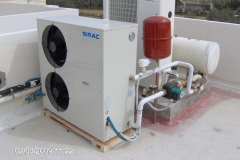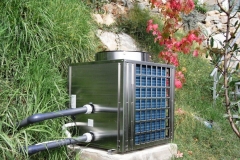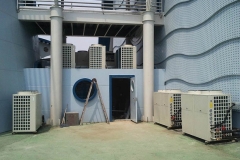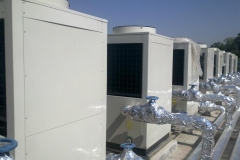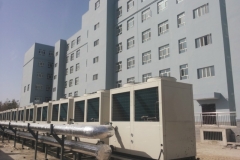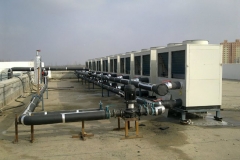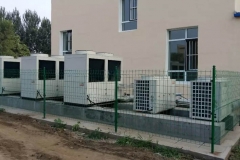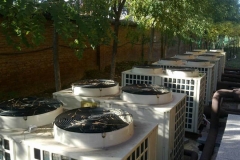| How does a HPWH work? |
|
Heat pump is a promising technology that uses the same mechanical principles as refrigerators and air conditioners to generate hot water. Unlike conventional electricity and fossil-fuel-fired water heaters, heat pump takes heat from the surrounding air/water/soil and transfer it to the water in the tank.
|
 |
The heat pump works by taking heat from the surrounding air/water/soil and using it to heat low pressure liquid refrigerant in the heat pump’s evaporator, vaporizing the liquid. The refrigerant then passes through the compressor, which raises
the refrigerant pressure and thus the temperature as well. The heated refrigerant gas passes through the heat pump condenser, where it gives off its heat to the water and condenses back into the liquid state.The liquid refrigerant now passed through an expansion valve or capillary where the pressure is reduced and the cycle starts over.
|
|
Heat pumps mainly consist of a compressor, fan (applicable to air to water), evaporator and condenser. The compressor requires electricity to compress the refrigerant and vaporize it, and the fan requires a small amount of electricity to continually blow air across the evaporator coils when the unit is operating. The only electricity cost is the operation of the compressor and the fan in order to collect the free heat and pump it to the hot-water.
|
| Why a heat pump in preference to a traditional water heater |
| Heat Pump /Traditional Water Heaters Economy Comparisons |
| Heating 1000kg water from 20oC to 55oC requires 35000Kcal |
| Heater Type |
Coal Boiler |
Fuel Boiler |
Gas |
Resistance |
Electric-boosted Solar |
HPWH |
| Energy Source |
Coal |
Diesel |
Gas |
Electricity |
Solar & Electricity |
Electricity & Air |
| Pollution |
Very High |
High |
Moderate |
None |
None |
None |
| Life Span |
5 years |
8 years |
8 years |
8 years |
8 years |
15 years |
| Hazard |
Moderate |
High |
Very High |
Moderate |
Moderate |
None |
| Fuel Value |
5000kcal/kg |
8550kcal/kg |
26000kcal/m3 |
860kcal/kwh |
860kcal/kwh |
860kcal/kwh |
| COP value |
0.55 |
0.65 |
0.65 |
0.96 |
3.3 |
3.8 |
| Heat Value |
2750kcal/kg |
6630kcal/kg |
16900kcal/m3 |
826kcal/kwh |
2838kcal/kwh |
3268kcal/kwh |
| Unit Energy Cost |
¥0.70/kg |
¥3.50/kg |
¥12.8/m3 |
¥0.66/kwh |
¥0.66/kwh |
¥0.66/kwh |
| Energy Consumption |
12.7kg |
6.3kg |
2.07m3 |
42.37kwh |
12.3kwh |
10.7kwh |
| Energy Cost per ton |
¥8.89 |
¥22.05 |
¥26.51 |
¥27.96 |
¥8.12 |
¥7.06 |
| Annual Energy Cost |
¥3200 |
¥8100 |
¥9700 |
¥10200 |
¥2930 |
¥2540 |
| Annual Labor Cost |
¥4000 |
¥2000 |
¥2000 |
0 |
0 |
0 |
| Annual Operation Cost |
&7200 |
¥10100 |
¥11700 |
¥10200 |
¥2930 |
¥2540 |
|
|
Remarks:
1) 95 rainy and cloudy days per year in the case of electric-boosted solar water heater.
2) ¥ is the symbol of China’s currency RMB. Current exchange rate is 1USD=7.91RMB.
3) Above data are based on the energy market in Guangdong, China. The data are for reference only. Actual cost analysis should be conducted according to local markets.
4) According to the table:
Heat pump is even 13% more energy saving than electric-boosted solar water heater;
Retrofitting electric-boosted solar water heating system with heat pump-boosted system can cut operation cost by 75%.
|
|
 |
1. Easier installation and requires much less installation space.
2. Heat pump will work at night.
3. Heat pump can deliver more hot water over the day.
4. Heat pump works well in all weather conditions.
5. In a commercial installation of heat pump the air duct can be connected to output of air conditioning system to give improved performance.
6. Able to deliver free cooled air simultaneously to satisfy additional cooling requirements.
|
|
| Applications |
|
Heat pumps are ideal in situations such as a commercial kitchen or laundry where there is a steady simultaneous need for cool air and hot water. They are widely used in hotels, restaurants, hospitals, underfloor house heating and swimming pools/spas.
|
|


